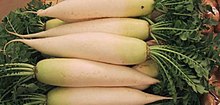Daikon: Difference between revisions
+names |
I expect a discussion instead of edit warring without any specific reasoning |
||
| Line 23: | Line 23: | ||
The flavour is generally rather mild compared to smaller radishes. |
The flavour is generally rather mild compared to smaller radishes. |
||
==Names== |
|||
Daikon is called ''mu'' in [[Korean Language|Korean]]; ''bai luobo'' ([[wikt:白萝卜|白萝卜]]) in [[Mandarin Chinese]]; ''lobak'', ''loh bak'', ''lo-bok'', or ''lo baak'' in [[Standard Cantonese|Cantonese]]; ''labanos'' in [[Tagalog Language|Tagalog]]; ''daigo'' in [[Chamorro language|Chamorro]]; and ''củ cải trắng'' in [[Vietnamese Language|Vietnamese]].<ref>Charmaine Solomon, Encyclopedia of Asian Food, Periplus 1998.</ref> |
|||
==Culture== |
==Culture== |
||
Revision as of 17:57, 20 December 2009
This article needs additional citations for verification. (December 2009) |
| Daikon | |
|---|---|

| |
| A pile of daikon radishes. | |
| Scientific classification | |
| Kingdom: | |
| (unranked): | |
| (unranked): | |
| (unranked): | |
| Order: | |
| Family: | |
| Genus: | |
| Species: | |
| Variety: | R. sativus var. longipinnatus[1]
|
| Trinomial name | |
| Raphanus sativus var. longipinnatus | |
Daikon (from Japanese ダイコン (daikon), literally "large root"), Raphanus sativus var. longipinnatus, is a mild-flavored, very large, white East Asian radish. Despite being known most commonly by its Japanese name, it did not originate in Japan, but rather in continental Asia.
Although there are many varieties of daikon, the most common in Japan, the Aokubi-daikon, has the shape of a giant carrot, approximately 20 to 35 cm (7.9 to 13.8 in) long and 5 to 10 cm (2.0 to 3.9 in) in diameter. One of the most unusually shaped varieties of daikon is the turnip-shaped Sakurajima-daikon often grows as large as 50 cm (20 in) in diameter and weighs as much as 45 kg (99 lb) cultivated in Kagoshima Prefecture.[2]
The flavour is generally rather mild compared to smaller radishes.
Culture
The examples and perspective in this article may not represent a worldwide view of the subject. (December 2009) |

The variety 'Long White Icicle' is available as seed in Britain, and will grow very successfully in Southern England, producing roots resembling a parsnip by midsummer in good garden soil in an average year.[citation needed]
Storage
The roots can be stored for some weeks without the leaves if lifted and kept in a cool dry place. If left in the ground the texture tends to become woody, but the storage life of untreated whole roots is not long.[clarification needed]
Nutritional information
Daikon is very low in food energy. A 3 ounce (85 g) serving contains only 18 Calories (75 kJ) but provides 34 percent of the RDA for vitamin C. Daikon also contains the active enzyme myrosinase.
Notes
- ^ Mish, Frederick C., Editor in Chief. “Daikon.” Webster’s Ninth New Collegiate Dictionary. 9th ed. Springfield, MA: Merriam-Webster Inc., 1985. ISBN 0-87779-508-8, ISBN 0-87779-509-6 (indexed), and ISBN 0-87779-510-X (deluxe).
- ^ The New official guide: Japan. Japan National Tourist Organization. 1975. p. 837. ISSN 0077-8591.
